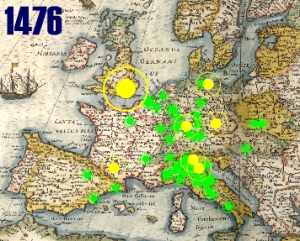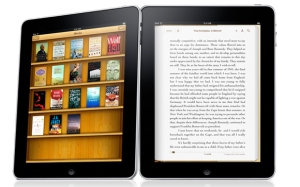Prior to the development of printing virtually every book and every document was a manuscript. They were developed through intense time consuming labour, “a centuries old, labour intensive, undercapitalised form of production was able to create only a very few texts for an elite market.” (Sawday,p5) This way of producing a manuscript was extremely expensive and it ultimately separated people more as the rich and the poor were now not only divided through wealth, they were now being divided through education. Only those who could afford to have these manuscripts would be able to see them. Only very popular texts of universal appeal would have been produced. Wood cut printing was in use prior to Gutenberg’s development of the printing press. This was another time consuming labour as a new block had to be carved in reverse for each page. A video of how woodcut printing can be seen here As a result few works justified the intensity of labour required for publication by this method. Prior to the invention of the printing press, buyers were more involved in the development process of their book. “Despite the gradual appearance of the book buyers in the fifteenth century, the circulation of books was undoubtedly far more limited in the absence of print technology.” (Sawday, p5) So with the development of the printing press we can see the first stages of the importance and impact of print, and the importance of the distribution of books and information. Although it is nothing in comparison to how information is spread today, it was for its time a huge development that would one day lead to the computers we have today, and the vast amount of information available freely and easily to us.
The development of print ultimately changed the world and paved the way for the increase in the spread of information. There are inevitably many benefits to the development of print, Education and religion are two areas that benefited greatly. Martin Luther evidently used print for the spread of his own ideas and the criticism of the Catholic Church. He is arguably one of the most famous examples “of the power of this new technology to participate in or even precipitate radical change.” ( Sawday, p5)Martin Luther’s writings on indulgences have been seen as founding texts in the Protestant Reformation. Luther’s ideas were able to pass through countless cities spreading his views on Religion. This aspect of the same ideas being shown to vast amounts of different people in different countries is an amazing achievement as it helped spread information like never before. “Luther’s exploitation of this new medium gives us an insight into the ways in which the energies unleashed by the printing press, like those generated by the computer today, were beyond the power of any one individual to master.” The development of print opened up a new way in which knowledge was able to circulate faster and the print itself wouldn’t be altered through word of mouth. Education is another area that was drastically altered for the better with the development of print. Print ultimately led to more people being educated, as more books became easily available. The printing press inevitably had a positive impact on people’s education, with the development of the printed book students were able to learn better. It is apparent that the development of print transformed learning in a positive way. According to Elizabeth Einstein, “Young minds provided with updated editions, especially of mathematical texts began to surpass not only their own elders but the wisdom of ancients as well.”(Einstein, p689) Intelligent people were able to access educational books and enhance their knowledge of geography physics, maths and above all their own minds. Gutenberg’s invention made it more accessible for poorer people to educate themselves in a time when illiteracy was rampant among the poorer classes of society. The printing press increased literacy by making books more accessible and this drastically altered how people were being educated, and how people were getting a better knowledge of the world they inhabited. “When the press began to be worked, hundreds of copies materialised in less time than it took to speak the text.” (Shillinsburg,p1)
The printing press had a huge impact on how information was processed and distributed to vast numbers of people. The development of print enhanced the world for the better as information became more easily and freely available, similarly to how information is available today. The computer inevitably impacted people in a similar way the development of print impacted people over five hundred years ago. It is evident that the days of spending hours looking through countless books for the information you require is a thing of the past, as information about everything is easily available with a few clicks of the mouse. The development of the computer has enhanced the world and has made it a much smaller place. People can find out all the information they wish to know without ever leaving their house. It is possible for people today to experience different cultures and see different places sitting in front of a computer or laptop. Prior to the development of the computer and the internet people were only able to experience and learn about different places by reading a book. The way in which information is made available has completely changed, making it far more easier to access. It is evident the printing press was a way of making information spread faster however the development of the computer has taken that to a completely different level in how advanced it is. According to Peter L. Shillingsburg, it makes you wonder “in 500 years, would anyone stand to look at a museum display of the first electronic book,” (Shillinsburg,p1) like we do today visiting copies of the first books printed in the Gutenberg museum. If we have developed something so advanced in how information is spread, what will be around in 500 years? It is evident that even today the computer is still evolving as information is becoming increasingly more available at an ever increasing rate. In five hundred years we have gone from vast amounts of books being printed in order to have the spread of information, to this slowly becoming a thing of the past. Books are in the midst of being replaced by EBooks, IPods and laptops. It is now possible to visit a library and read as many books as you wish without ever leaving your house. Information is more accessible with these new developments. EBooks have allowed people to read as many books as they wish and they are inevitably replacing a hard copy. It is cheaper and more convenient to read a book on your EBook as you are not restricted by weight and room like you would be with vast amounts of hard copies. To watch the difference between a book and an EBook click here
By, Sinead Reed
Bibliography
• Einstein, Elizabeth. The printing press as an agent of change. Cambridge, Cambridge University Press, 1980.
• Mcluan, M. The Gutenberg galaxy: the making of typographic man. Toronto, University of Toronto Press, 1962.
• Sawday, Jonathan. The Renaissance Computer: knowledge technology in the first age of print. London, Routledge, 2000.
• Shillingsburg, L. Peter. From Gutenberg to Google: electronic representations of literary texts. Cambridge, Cambridge University Press, 2006.
• http://www.youtube.com/





[…] The development of the printing press, from print to the computer and EBooks (diginarrate.net) […]